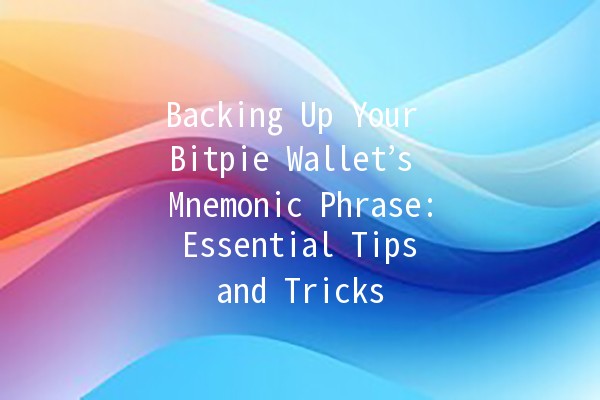




In the rapidly evolving world of cryptocurrency, keeping your assets secure is crucial. One fundamental aspect of security for any crypto wallet, including the Bitpie wallet, is the mnemonic phrase. This article provides practical tips for backing up your Bitpie wallet's mnemonic phrase to ensure you never lose access to your funds and demonstrates how to safely store and retrieve it.
A mnemonic phrase, often referred to as a recovery phrase or seed phrase, is a series of words that serves as a master key to your cryptocurrency wallet. Here’s why it is critical:

One of the simplest and most effective ways to back up your mnemonic phrase is to write it down on paper.
Explanation: Physical writing reduces the risk of digital theft. If done correctly, this method can be safer than storing your mnemonic phrase online.
Practical Example: After generating your mnemonic phrase, write it down on a piece of paper. Use a pen to ensure clarity, and doublecheck the words to avoid mistakes. Once written, store the paper in a safe place, such as a lockbox or safety deposit box. Make sure it's a location that only you or trusted individuals have access to.
For enhanced security, consider using a hardware wallet, which stores your mnemonic phrase offline.
Explanation: A hardware wallet is a physical device that securely manages your cryptocurrencies. It keeps your mnemonic phrase out of reach from online hackers.
Practical Example: Popular hardware wallets like Ledger or Trezor allow you to export your mnemonic phrase securely. When setting up your wallet, ensure you follow the guidelines for creating and backing up your mnemonic phrase. Always keep the device itself secure and protected with a strong PIN.
Multisignature wallets require more than one key to authorize a transaction, providing an additional layer of security.
Explanation: By splitting your mnemonic phrase across multiple wallets, you decrease the risk of losing access to your funds if one wallet is compromised.
Practical Example: Set up two wallets—one that holds the primary mnemonic phrase and another that contains a partial key or backup. Whenever you need to access your funds, both keys must be used in conjunction. This way, even if one wallet is lost or hacked, your funds remain protected.
For those who prefer digital storage, consider using an encrypted file.
Explanation: Digital backups are convenient, but they can be vulnerable to hackers. Encrypting your mnemonic phrase adds an extra layer of security.
Practical Example: Use software like VeraCrypt to create an encrypted volume on your computer or cloud storage service. Store your mnemonic phrase in this encrypted file. Make sure to use a strong password for the encryption. Remember: if you forget this password, you will lose access to your mnemonic phrase.
Changing technology and personal circumstances may necessitate an updated backup of your mnemonic phrase.
Explanation: As you evolve your crypto strategy or if you change devices, ensure that your backups reflect any changes in your wallet.
Practical Example: Periodically review and, if necessary, regenerate your mnemonic phrase through your Bitpie wallet. When you create a new phrase, remember to update any written or digital backups. Regularly check your storage methods to confirm they remain secure and accessible.
Q1: What should I do if I lose my mnemonic phrase?
Losing your mnemonic phrase means you've lost access to your wallet and funds. Unfortunately, without this key, recovery is almost impossible. This emphasizes the necessity of making secure backups.
Q2: Is it safe to store my mnemonic phrase on my computer?
Storing your mnemonic phrase on your computer is risky unless it's within an encrypted document. If you must save it digitally, ensure it's encrypted and stored offline where possible.
Q3: Can I share my mnemonic phrase with anyone?
You should never share your mnemonic phrase with anyone. Anyone who has this phrase can access and control your wallet entirely.
Q4: What happens if I write down my mnemonic phrase incorrectly?
If any word in your mnemonic phrase is incorrect, you will not be able to access your wallet. Always doublecheck your writing and ensure you have the correct order of words.
Q5: How frequently should I change my mnemonic phrase?
While there’s no strict rule, consider changing your mnemonic phrase if you believe your security may have been compromised or if you change wallets. Regular updates help keep your assets secure.
Q6: How do I know if my backup is secure?
Test the security of your backup by attempting to access your wallet using your recovery method. If you can restore access without issues, your process is likely secure. Additionally, regularly assess your storage methods and the complexity of your passwords.
By taking these essential steps to back up your Bitpie wallet’s mnemonic phrase, you can significantly reduce the risks of losing your cryptocurrencies and ensure your assets remain secure. Embrace these practices today to safeguard your financial future in the decentralized landscape of digital currencies.